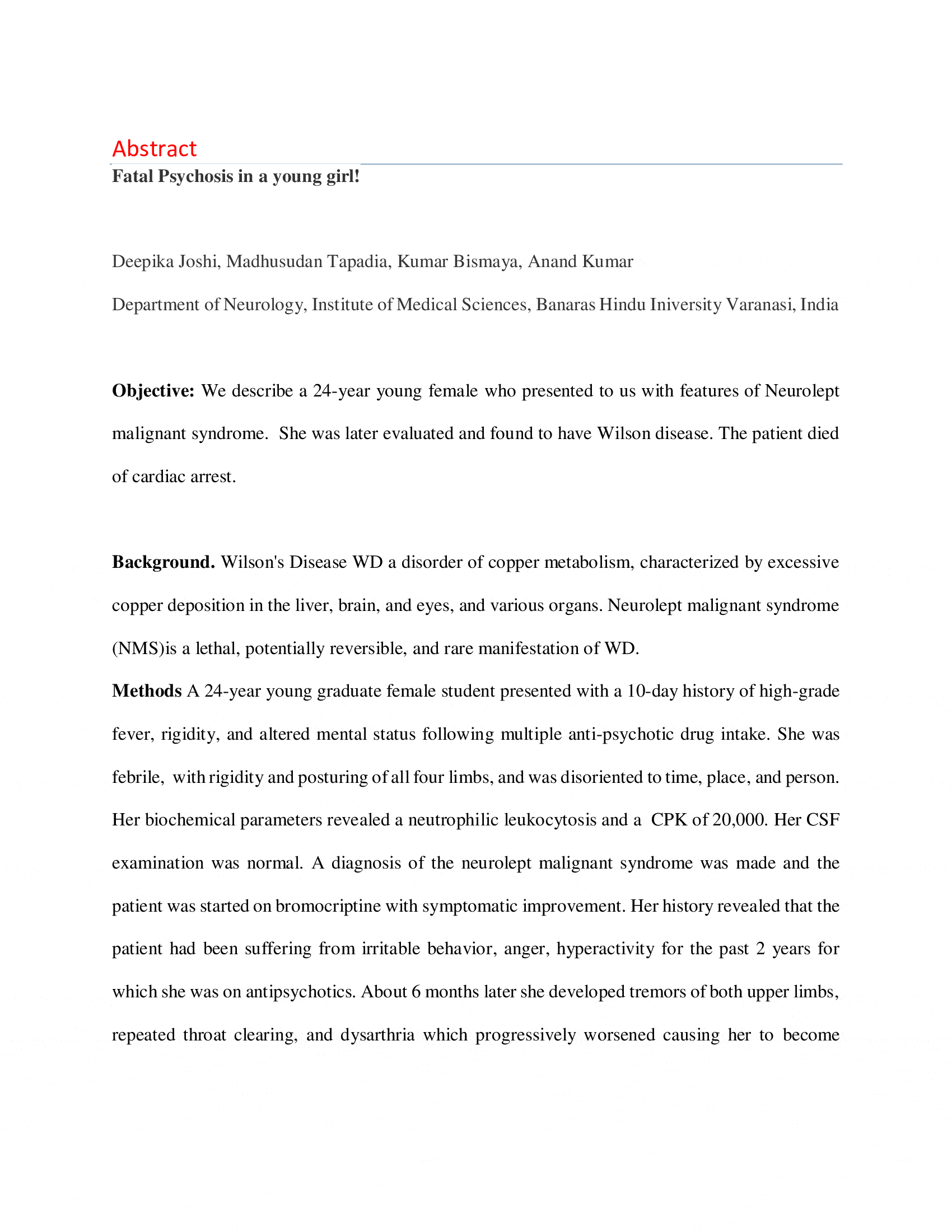Category: Drug-Induced Movement Disorders
Objective: We describe a 24-year young female who presented to us with features of Neurolept malignant syndrome. She was later evaluated and found to have Wilson disease. The patient died of cardiac arrest.
Background: Wilson’s Disease WD a disorder of copper metabolism, characterized by excessive copper deposition in the liver, brain, and eyes, and various organs. Neurolept malignant syndrome (NMS)is a lethal, potentially reversible, and rare manifestation of WD
Method: A 24-year young graduate female student presented with a 10-day history of high-grade fever, rigidity, and altered mental status following multiple anti-psychotic drug intake. She was febrile, with rigidity and posturing of all four limbs, and was disoriented to time, place, and person. Her biochemical parameters revealed a neutrophilic leukocytosis and a CPK of 20,000. Her CSF examination was normal. A diagnosis of the neurolept malignant syndrome was made and the patient was started on bromocriptine with symptomatic improvement. Her history revealed that the patient had been suffering from irritable behavior, anger, hyperactivity for the past 2 years for which she was on antipsychotics. About 6 months later she developed tremors of both upper limbs, repeated throat clearing, and dysarthria which progressively worsened causing her to become incomprehensible. Her behavioral symptoms worsened causing the psychiatrist to increase her dose of antipsychotics about 2 weeks before admission.
Results: O/E there was KF ring present, serum ceruloplasmin was low(9.18mg/dl), 24 hours urinary copper (171microgram/L) was elevated and her MRI Brain revealed B/L symmetrical T2 hyperintensities in the basal ganglia suggestive of WD. She was started on symptomatic treatment with zinc and trihexyphenidyl, with penicillamine slowly introduced. The patient showed an initial improvement and became oriented about 10 days of treatment. However, she later developed hypotension with sinus bradycardia. She was advised TPI which was refused by the attendants. Her 2 D ECHO was normal. Cardiac MRI was planned but could not be done because of the involuntary movements. She died of cardiac arrest subsequently.
Conclusion: Thus onset with neuropsychiatric features led to a delay in diagnosis with the antipsychotics drugs causing an additional menace in the form of NMS. The cardiac involvement possibly as a part of NMS or copper deposition as has been described in few cases of WD is the cause of mortality in this young girl.
References: References 1.Kontaxakis V, Stefanis C, Markidis M, Tserpe V. Neuroleptic malignant syndrome in a patient with Wilson’s disease. J Neurol Neurosurg Psychiatry. 1988 Jul;5 2Kuan P. Cardiac Wilson’s disease. Chest 1987;91:579-83. 3Fatima J, Karoli R, Siddiqui Z, Chandra A, Jain V. Hepatolenticular degeneration – Is the term too narrow to explain Wilson’s disease? J Assoc Physicians India 2014;62:531-3 4.Aurélia Poujois, France Woimant. Challenges in the diagnosis of Wilson disease Ann Transl Med. 2019 Apr; 7(Suppl 2): S67. doi: 10.21037/atm.2019.02.10. 5.L K Prashanth, A B Taly, S Sinha, G R Arunodaya, H S Swamy.Wilson’s disease: diagnostic errors and clinical implications . J Neurol Neurosurg Psychiatry 2004;75:907–909. doi: 10.1136/jnnp.2003.026310
To cite this abstract in AMA style:
D. Joshi, M. Tapadia, K. Bismaya, A. Kumar. Fatal Psychosis in a young Girl [abstract]. Mov Disord. 2021; 36 (suppl 1). https://www.mdsabstracts.org/abstract/fatal-psychosis-in-a-young-girl/. Accessed April 1, 2025.« Back to MDS Virtual Congress 2021
MDS Abstracts - https://www.mdsabstracts.org/abstract/fatal-psychosis-in-a-young-girl/

